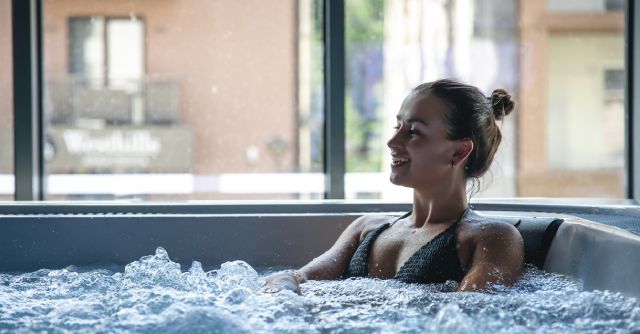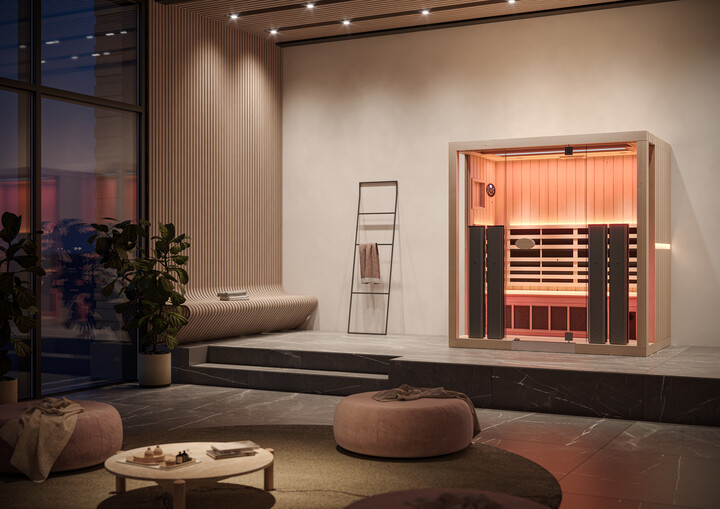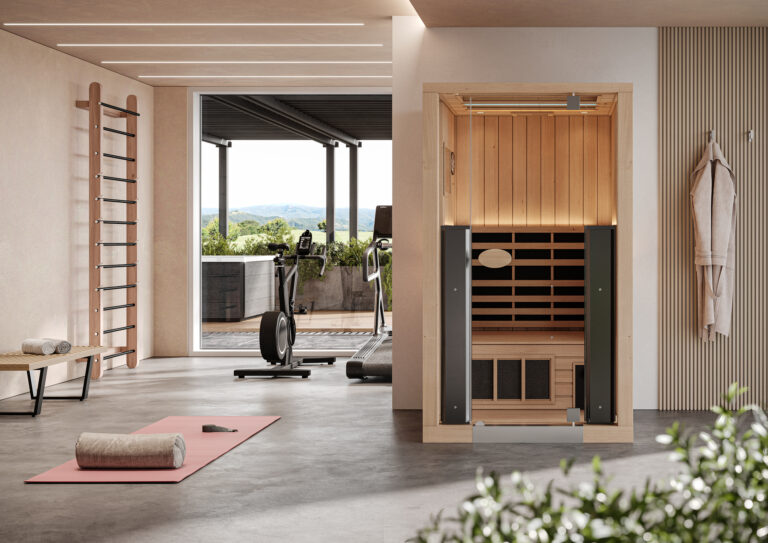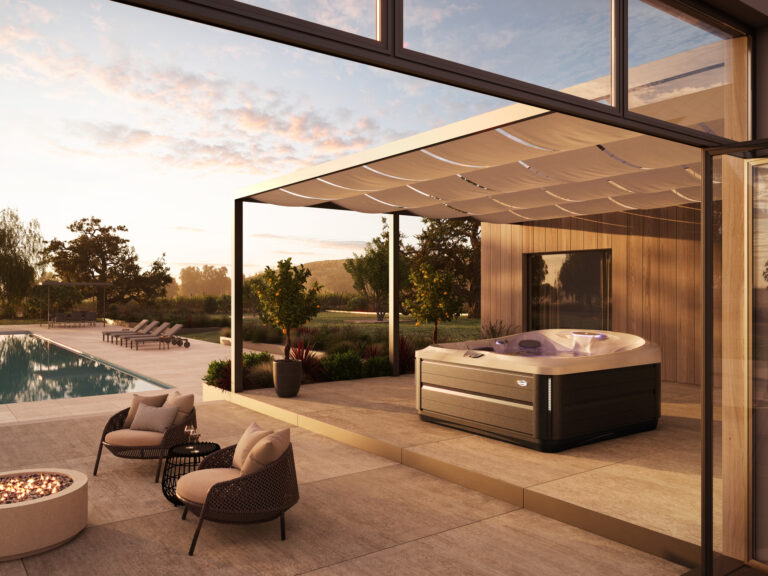Choosing where to install your hot tub can be challenging, especially if you’re debating between an indoor or outdoor installation.
Many people wonder if an indoor hot tub installation would be a good fit for them or if their chosen model can even be installed indoors.
The good news is these installations are much more possible than many first believe and boast a range of benefits that will leave you even more excited for delivery day.
Any hot tub installation takes work and precise planning, with indoor hot tubs requiring additional steps that you may not have to worry about with an outdoor spa.
In this article, we’re going to go through some of the pros and cons you can experience with an indoor hot tub installation, as well as the essential things you need to consider before your hot tub arrives.
Pros and Cons of Owning An Indoor Hot Tub Installation

While outdoor hot tubs are quite common, you won’t see an indoor hot but nearly as often.
An indoor hot tub installation can take various forms, with many people opting for a faux indoor installation by using a gazebo.
The problem with this is that many of the benefits indoor hot tubs offer can only be experienced through a true indoor hot tub installation where your spa is in a room in your house, such as a sunroom.
Pros
More Convenient
When you install your hot tub indoors, you’ll be able to easily use your spa without ever needing to leave the comfort of your own home.
This can be especially beneficial during the extreme weather conditions experienced throughout the winter months. You’ll not only get to skip the chilly walk out to your hot tub, but you also won’t have to brush snow off your cover before jumping in!
More Energy Efficient
While hot tubs are designed using dense insulation that leaves them surprisingly energy efficient, even in the coldest of climates, a small indoor hot tub can take that efficiency even further.
Because your hot tub isn’t exposed to fluctuating weather conditions and is in a temperature-regulated indoor hot tub room, it’s better able to maintain its heat.
Not only will this make your hot tub even more energy efficient, but it will also reduce the work your systems need to do to maintain your water temperature.
Maximum Privacy
With outdoor hot tub installations, you can increase privacy by investing in screens, gazebos or pergolas, but it’s not an easy task to create a luxurious private oasis in your backyard.
With an indoor installation, however, your spa is completely private, ensuring you can have a relaxing session without having to worry about prying eyes or any neighboring homes that are high enough to peek into your backyard.
This makes for a much more soothing experience, allowing you to fully sink into the crystal clear water and let your guard down, leaving you completely relaxed and at ease throughout each session.
Better Protection
Indoor hot tubs experience far less wear and tear than their outside counterparts because they’re not subjected to the same harsh outdoor elements.
This not only extends the lifespan of their cabinetry and cover but also reduces the amount of time you need to spend maintaining them over the years.
Cons
While indoor hot tubs can provide some impressive benefits you can’t enjoy with any other installation, they also come with some cons that you should be prepared for before choosing this installation.
They Are Expensive
Indoor hot tub installations require more work and additional effort for the technicians as they perform the installation, leading to a higher price tag.
However, the installation isn’t the only aspect that can leave you paying more money to have a hot tub inside. Your insurance might even climb a bit higher because you have a significant water source in the house.
While this isn’t always the case, it’s best to check with your home insurance provider prior to the installation to find out for sure.
More Moisture In Your Home
Even when covered, hot tubs create a significant amount of moisture in the air, which, if not properly planned for, can lead to issues developing in your home over time.
The good news is that with the proper steps, you’ll be able to ensure the humidity from your hot tub doesn’t affect the quality of your room. We’ll get into this more below.
Potential For Strong Odours
The chemicals you use to maintain your water quality can leave a slight odor in the air, which may not be ideal for some people.
While hot tubs should never give off a strong chlorine smell, with an indoor installation, yours may smell slightly stronger than what you would experience with an outdoor spa.
Luckily, odors from your indoor hot tub can be combated with proper ventilation and well-balanced water.
6 Things to Consider For Indoor Hot Tub Installation

If you’re planning on an indoor hot tub installation or are simply trying to get a better understanding of what to expect should you opt for this style, here are six things you should consider.
1. How You’ll Get Your Hot Tub in The Room
Before you can even settle on an indoor hot tub installation, you’ll need to know if you can get it into the room you’ve chosen for it.
Hot tubs aren’t small or light, and fitting them into a room is no easy task.
One of the most popular ways people create an indoor hot tub installation is by putting their hot tub in a room that has wide double doors that allow for it to be moved in. Others choose to build a separate room around their hot tub after it’s installed, similar to a house extension.
Whichever options you choose, you’ll need to be confident you can fit your hot tub into the room you want it in. If you have no way of getting it into the room, you’ll need to reconsider your indoor installation or come up with an alternative plan.
2. Ventilation
As mentioned above, hot tubs produce a significant amount of moisture, which needs to have somewhere to go. If you don’t have adequate ventilation, you could be left with water damage on your walls or ceiling, wreaking havoc on your room.
This is important for more than just the moisture, though. You’ll also need ventilation to ensure your spa room doesn’t fill up with harmful fumes from your treatment products.
Each time you treat your water, the chemicals will off-gas. This essentially means that as they treat your water, they produce a gas that’s released into the air. If you don’t have proper ventilation, these gases have nowhere to go and can cause damage to the interior of your room.
This can also create an unsafe soaking experience, leading to increased chemical levels in your water!
This can easily be avoided by ensuring you plan for optimal ventilation, whether it be through a system or windows and doors you can open to allow the gas to escape outside.
3. Drainage
Your drainage requirements come in two forms for an indoor installation.
First, you’ll need a way to fully drain your spa when it comes time to clean it. This gets done every three months, so you’ll want it to be something that can be easily done.
For some people, this is as simple as keeping their spa near an outside door so they can use a quick drain hose that brings the water into their backyard, whereas others simply attach their garden hose to the drain spout and unravel it to their nearest exit from the house.
Secondly, you’ll also need drainage options built into your floor to make removing any spilt water on your flooring easy. Each time you use your hot tub, you’re bound to end up with water on the floor.
This water can damage your flooring or become slippery if you don’t have a built-in way to drain it. For many people, this comes down to simply adding a floor drain into their spa room or a perimeter drain around their hot tub’s foundation.
4. Your Floor Material
While we’re on the topic of your flooring, you’ll want to ensure the floor in your spa room can withstand the water and humidity that comes with housing a hot tub.
There are plenty of water-resistant flooring options you can consider, such as:
- Ceramic Tile
- Sheet Vinyl
- Vinyl Tile
- Concrete
You’ll also want to ensure that the flooring you choose isn’t going to become slippery once it’s wet. Some people do this by laying down rubber mats or buying a textured, anti-slip flooring material.
5. Your Hot Tub Foundation
No matter where you install your hot tub, you’ll need to ensure it has a solid, level foundation to sit upon.
Hot tubs are heavy, especially once they’re filled with water. If they’re installed on an uneven surface, this weight can cause warping to your hot tub’s cabinet, leaving you with costly repairs in the future.
Most people install a level concrete pad for their hot tub, however, if your room already has a solid, water-resistant floor that’s perfectly level, you’ll be able to install your hot tub directly on that.
6. Where Your Spa Will Be Placed
Once your hot tub is installed, it’s not easy to move, so choosing where in your room your hot tub will be installed is essential.
When choosing where to put your spa, you should consider a few things:
- What’s most aesthetically pleasing?
- Where is your water source located?
- What is the height of your ceilings, and is there a section with more space above it?
- How big is your room?
Answering these questions will help you choose the perfect spot to place your hot tub, ensuring it not only looks great but is easy to access and care for after it’s been installed.
Indoor Hot Tubs For Sale in Calgary
Whether you’re working towards creating the ideal private oasis or want to boost your home’s value, adding an indoor hot tub may be the answer you’re looking for.
At Jacuzzi Hot Tubs of Calgary, we’re bringing top-quality spas to the members of our community, ensuring it’s easy for everyone to enjoy the benefits of a Jacuzzi®️ Hot Tub.
Visit our showroom or contact us to get started today!





 by
by